An online project under the direction of the CAPE ANN MUSEUM
inv. 74
Dream Painting
1862 Oil on canvas 24 x 36 in. (61 x 91.4 cm) Signed and dated lower left: Fitz H. Lane 1862
|
Related Work in the Catalog
Supplementary Images
Additional material
Explore catalog entries by keywords view all keywords »
Historical Materials
Below is historical information related to the Lane work above. To see complete information on a subject on the Historical Materials page, click on the subject name (in bold and underlined).
Newspaper clipping
Cape Ann Advertiser
Collection of Fred and Stephanie Buck
"MARINE PAINTING. – Mr. F. H. Lane is now engaged in painting a beautiful marine picture, the subject of which was revealed to him in a dream, and retained sufficiently in his mind to enable him to give a very faithful conception of it on the canvass. The scene represents a ship ashore on a ledge of rocks, against which the angry waves beat furiously, throwing their spray over the dismantled vessel, producing a most life-like appearance. The storm has spent its fury, and the sun bursting through the clouds gives a most gorgeous effect to the picture, which for accuracy and truthfulness of delineation we have never seen equalled. As one gazes upon the scene, they seem to forget they are gazing upon a painted canvass, and for the time being imagine themselves standing on the shore, gazing out upon the stormy ocean and the shipwrecked vessel on the rocks. It is a picture which one can gaze upon for a long while and not grow weary. We learn that it is the intention of the artist to place it on exhibition, when finished, before sending it to the city."
Filed under: Newspaper / Journal Articles » // Studio Descriptions »
Letter
Terra Foundation for American Art, Chicago
A letter affixed to the verso of Lane's Dream Painting of 1862 in which he describes how the idea for the painting came to him in a dream. Lane writes: "This picture, the Property of John S. Webber Esq, Collector of the Port and District of Gloucester, was (suggested) to the artist by a dream. Sometime last fall while asleep in bed, a richly furnished room was presented to my imagination. Upon the wall my attention was attracted to a picture which I have here endeavored to reproduce. The dream was very vivid and on awakening I retained it in memory for a long time. The effect was so beautiful in the dream that I determined to attempt its reproduction, and this picture is the result. The drawing is very correct, but the effect falls far short of what I saw, and it would be impossible to convey to canvas such gorgeous and brilliant colouring as was presented to me. This picture, however, will give to the beholder some faint idea of the ideal. /signed/ Fitz H. Lane."
Filed under: Chronology » // Davidson, Dr. Herman Elvas » // Letters » // Letters / Manuscripts » // Signature / Name change » // Webber, John Somes »
In the ninteenth century, the term "bark" was applied to a large sailing vessel having three masts, the first two (fore and main) being square-rigged; the third (mizzen), fore-and-aft rigged. The reduced square-rig made the vessel easier and more economical to handle, using a smaller crew. (1)
Barks had significant presence in mid-nineteenth-century America, as indicated by Lane’s depictions of them. Hardly any are to be found in his scenes of major ports, but some do appear in his Cape Ann scenes (see The Fort and Ten Pound Island, Gloucester (Harbor Scene), 1848 (inv. 58), View of Gloucester, 1859 (inv. 91), Gloucester Harbor, 1850s (inv. 391), and Bark "Eastern Star" of Boston, 1853 (inv. 571)), also in views of other small ports and of coastal shipping (see Clipper Ship "Southern Cross" in Boston Harbor, 1851 (inv. 253), Merchantmen Off Boston Harbor, 1853 (inv. 267), Approaching Storm, Owl's Head, 1860 (inv. 399), and Bark "Mary" (inv. 629)).
Brigs, and to a lesser extent ships, were the vessels of choice for Gloucester’s foreign trade in the first half of the nineteenth century. They brought cargos from the West Indies, South America, and Europe, anchoring in the deeper parts of the Inner Harbor while lighters off-loaded the goods and landed them at the wharves in Harbor Cove, by then too shallow for the newer, larger merchant vessels coming into use. (2) By mid-century, barks were gradually replacing brigs and ships, while the trade with Surinam was removed to Boston in 1860. (3)
Some bulk cargos still had to be landed in Gloucester, salt for curing fish being the most important. “Salt barks” brought Tortugas salt from the West Indies, and in the 1870s, Italian salt barks began bringing Trapani salt from Sicily. The importation of salt by sailing ships ended with the outbreak of World War I. (4)
The term barkentine, like the bark, pre-dates the nineteenth century, but in the mid- to late 1800s referred to a large vessel of three masts (or more), with only the fore mast square-rigged, the others being fore-and-aft-rigged. In Lane’s time, the term was little known in the United States, while many other names were coined for the rig. One of these early terms was demi-bark, probably from the French demi-barque, which was applied to a very different kind of vessel. (5) Lane’s depictions of these rigs include a lithograph of the steam demi-bark "Antelope" View of Newburyport, (From Salisbury), 1845 (inv. 499) and at least three depictions of Cunard steamships The "Britannia" Entering Boston Harbor, 1848 (inv. 49), Cunard Steamship Entering Boston Harbor (inv. 197), and Cunard Liner "Britannia", 1842 (inv. 259). (6) None of these subjects typify the barkentine rig as applied to sails-only rigs as they developed in the years after Lane’s death.
– Erik Ronnberg (May, 2015)
References:
1. R[ichard] H[enry] Dana, Jr., The Seaman's Friend (Boston; Thomas Groom & Co., 1841. 13th ed., 1873), 97 and Plate IV with captions; and M.H. Parry, et al., Aak to Zumbra: A Dictionary of the World's Watercraft (Newport News, VA: The Mariners’ Museum, 2000), 43.
2. Alfred Mansfield Brooks, Gloucester Recollected (Gloucester, MA: Peter Smith, 1974), 56, note 10; 67, note 7.
3. James R. Pringle, History of the Town and City of Gloucester (1892. Reprint: Gloucester, MA, 1997), 106–08.
4. Raymond McFarland, A History of the New England Fisheries (Philadelphia: University of Pennsylvania, 1911), 95–96; and Mark Kurlansky, Salt: A World History (New York: Walker & Co., 2002), 419–420.
5. Parry, 44, 167. Dana has neither definition nor illustration of this rig.
6. J[ohn] W. Griffiths, “The Japan and China Propeller Antelope," U.S. Nautical Magazine III (October 1855): 11–17. This article includes an impression of Lane’s lithograph on folded tissue.
Stereograph card
Cape Ann Museum Library & Archive
This view of Gloucester's Inner Harbor shows three square-rigged vessels in the salt trade at anchor. The one at left is a (full-rigged) ship; the other two are barks. By the nature of their cargos, they were known as "salt ships" and "salt barks" respectively. Due to their draft (too deep to unload at wharfside) they were partially unloaded at anchor by "lighters" before being brought to the wharves for final unloading.
– Erik Ronnberg
Also filed under: Historic Photographs » // Salt » // Waterfront, Gloucester »
Dr. Davidson (1815–90) was a close friend of Lane and his personal physician in Gloucester. He signed Lane’s death certificate. He and his wife received equal portions of Lane’s five-hundred-dollar legacy, and Dr. Davidson inherited Lane’s gold watch and chain.
The Davidsons lived in Gloucester from 1842 until 1878, and for most of that time inhabited the old Sanders house, now the Sawyer Free Library. Dr. and Mrs. Davidson were relatively wealthy, owning shares of gas, steamboat and railroad companies, “machinery used in manufacturing establishments,” a horse, a chaise, a large house with barn, an acre of land and two- to three-thousand-dollar “cash assets.” (1) Their land lay to the north of Middle Street along Mason Street, including what is now occupied by the Central Grammar apartments (the old high school). (2)
The house had been Beach’s house, with the rope walk behind, but Phebe Wilson Davidson (Dr. Herman’s mother) bought it from the Eastern Railroad Company on February 19, 1850. (3) It was bequeathed to Herman E. Davidson by Phebe’s will, dated November 12, 1859. This elegant house and the gardens were drastically disrupted by the laying out of Dale Avenue in 1866, a year after Lane’s death, and the anguished doctor sued the Town.
The Davidsons also had an unwanted ring-side seat for the 1866 construction, the 1869 fiery destruction, and the 1871 reconstruction of the Town Hall on that newly laid-out Dale Avenue. Dr. Joseph Garland wrote of his older contemporary: "Dr. Davidson, was a thoroughly educated physician. He was of studious habits and deeply interested in scholarly pursuits. He was a skilled physician of the modern school of medicine, and never believed in crowding drugs into his patients. His practice was expectant—watching and waiting upon nature, and ever ready to assist her efforts in repelling or subduing disease. He soon acquired a good practice and secured the confidence of the community."
Edward Henry Lane wrote: “… Dr. Davidson … was one of his [uncle Lane’s] closest friends, and almost every Sunday, weather permitting, would find them together at the Doctor’s home.” (4) It was to the Davidson house that Lane fled and sought refuge during the time of unpleasantness with Ignatius Winter. It was in their upper bedroom that Lane slept and dreamt the famous dream of the painting on the wall. And it was to his hostess, Sarah M. Davidson, that Lane gave the sketch of this Dream Painting. Dr. Davidson was the first president of the Cape Ann Scientific & Literary Association, the predecessor to the Cape Ann Historical Association.
On August 9, 1859, Dr. Herman Davidson was married to Mrs. Sarah M. (Bowker) Chamberlain in Boston by Gloucester’s Universalist minister, Rev. W. R. G. Mellen, who was Mary Mellen’s brother-in-law. Herman was forty-four and Sarah was thirty-two. (5) They continued to live in Gloucester until 1878—having traveled abroad from 1872 to 1875—when he left on account of his wife’s health, to reside in the milder climates of this country. She died at Washington, D.C. on May 16, 1880. After traveling abroad for several years he died at Northeast Harbor, Mount Desert, Maine, in 1890.
Among the many inventions devised by the doctor was the Davidson Bulb Syringe now universally in use, and a meat press "that anyone can use to press all the juice from the beef into a dish for the use of invalids." (6) Still another invention was called “Davidson’s Method in Ichthytaxidermy” or the mounting of fish for use in the study of Natural History.
In Gloucester, Davidson was a member of the school committee for several years, the first President of the Cape Ann Scientific & Literary Association, Vice President of the Cape Ann Horticultural Society, one of the Corporators of Oak Grove Cemetery, and a member of the Board of Trustees until his departure from the City.
Dr. Davidson was buried in Oak Grove Cemetery, not far from the Stevens plot and the grave of Fitz Henry Lane. (7) His and his wife Sarah’s remains were removed to the more outlying plot #283 on Jasmine Lane in 1947, when his original gravesite was sold back to the Oak Grove Cemetery by his daughter Alice Davidson Tilton. (8) The bronze plaque on the large boulder at plot #283 reads: Hamilton Davidson 1787–1848; Phebe Davidson 1785–1858; Herman E. Davidson M.D. 1815–90; Charles H. Davidson 1812–60; Mary Jane Davidson 1820–36; Eliza Ann Delano 1817–53.
Alice Davidson Tilton gave View of Coffin's Beach, 1862 (inv. 41) to the Cape Ann Museum.
– Stephanie Buck (March, 2015)
(1) Assessor’s Valuations, Harbor Parish East Ward, 1862-64. Gloucester Archives, CC223.
(2) D. G. Beers & Co., Map of the Built up Portion of the Town of Gloucester, Mass. 1872. Cape Ann Museum.
(3) Essex County, Salem, Registry of Deeds, Bk. 436, 293; and Bk. 563, 19.
(4) Edward H. Lane, Cape Ann Scientific & Literary Association. Weekly Column on Matters of Local History, Gloucester Daily Times, March 23, 1916.
(5) Massachusetts Vital Records, Marriages, Boston, vol. 128, 77.
(6) An unpublished obituary by Rhodes Lockwood, handwritten manuscript from the Authors and Artists of Cape Ann, Cape Ann Historical Association Scrapbook #86, as in Sarah Dunlap and Stephanie Buck. Fitz Henry Lane: Family and Friends. (Gloucester, MA: Church & Mason Publishing; in association with the Cape Ann Historical Museum, 2007), 85.
(7) Plot #452, Hickory Avenue, Section 7.
(8) Oak Grove records, Gloucester Archives.
Newspaper clipping
Cape Ann Advertiser
Collection of Fred and Stephanie Buck
"MARINE PAINTING. – F. H. Lane, Esq., has recently completed a picture for Dr. H. E. Davidson of this town. The painting represents a sunset scene in our harbor, which is taken near the cut bridge, introducing the beach covered with rocks and pebbles, steep bank, and Stage Fort, with the surrounding scenery in the vicinity. . . It is impossible to give an adequate idea of this painting by any description of ours, for it must be seen to be appreciated. It is the largest painting the artist has yet finished, and, in our opinion, his best. The painting is now on exhibition at the Studio, for a short time, where those who are interested in works of art can have an opportunity of viewing it."
Also filed under: Gloucester, Mass. – Eastern Point Light » // Newspaper / Journal Articles » // Studio Descriptions »
Newspaper clipping
Cape Ann Advertiser
Collection of Fred and Stephanie Buck
"MARINE PAINTING. – Mr. F. H. Lane has recently finished a splendid painting of Coffin's Beach, taken from the 'Loaf', which is one of the artist's happiest efforts. In the foreground is represented a ledge of cragged rocks over which the sea is tumbling in feathery foam; while stretching away to the right is the long sand beach and open bay. In the distance are seen the villages of Annisquam and Lanesville. The sun is just rising behind the hills, throwing his golden beams over the whole scene, forming a picture truly delightful to gaze upon. There is an air of solitary grandeur about the painting which we have seldom seen equalled, and we hope the artist will be induced to place it on exhibition for a few days."
Newspaper clipping
Cape Ann Advertiser
Collection of Fred and Stephanie Buck
"We learn that Dr. H.E. Davidson is shortly to exhibit to our citizens, some stereoscopic pictures on a large scale. The pictures are said to be truly magnificent, and are magnified to a great extent, showing every detail in a clear and life-like manner. The proceeds of the exhibition will be given to the Public Library, after paying the expense of the instrument. Due notice will be given of the the exhibition."
Also filed under: Newspaper / Journal Articles » // Sawyer Free Library »
Also filed under: Biographical information » // Funeral & Burial »
Letter
Terra Foundation for American Art, Chicago
A letter affixed to the verso of Lane's Dream Painting of 1862 in which he describes how the idea for the painting came to him in a dream. Lane writes: "This picture, the Property of John S. Webber Esq, Collector of the Port and District of Gloucester, was (suggested) to the artist by a dream. Sometime last fall while asleep in bed, a richly furnished room was presented to my imagination. Upon the wall my attention was attracted to a picture which I have here endeavored to reproduce. The dream was very vivid and on awakening I retained it in memory for a long time. The effect was so beautiful in the dream that I determined to attempt its reproduction, and this picture is the result. The drawing is very correct, but the effect falls far short of what I saw, and it would be impossible to convey to canvas such gorgeous and brilliant colouring as was presented to me. This picture, however, will give to the beholder some faint idea of the ideal. /signed/ Fitz H. Lane."
Also filed under: Chronology » // Letters » // Letters / Manuscripts » // Signature / Name change » // Webber, John Somes »
Essex County Probate Records, Volume 424, Leaves 34 & 35
The will disposed of Lane's property (including watch and diamond breast pin), his monetary assets, and gave to the city of Gloucester a painting of the Old Fort. Joseph Stevens, Jr. and T. Sewall Lancaster were named executors. It was signed by Lane on March 10, 1865.
Also filed under: Chronology » // Documents / Objects » // Funeral & Burial » // Galacar, Elizabeth » // Lancaster, T. Sewall » // Mellen, Mary Blood » // Page, Eben » // Stevens, Caroline Foster » // Stevens, Joseph, Jr. » // Wilbur, Horace B. »
Mrs. H. E. Davidson was a close friend of Lane's and the wife of his personal physician in Gloucester. Lane made several paintings from drawings for her, including the famous Dream Painting, 1862 (inv. 74).
Mrs. H. E. Davidson was Sarah M. (Bowker) Chamberlain (1827–80), and the wife of Dr. Herman E. Davidson (1815–90). She was born as Sally Morse Bowker, daughter of James and Izanna Bowker in Hopkinton, MA, April 29, 1827. (1) She married John Henry Chamberlain, merchant, in 1847 when she was twenty and he was thirty. (2) He died the following year in the Fiji Islands. She and Dr. Herman E. Davidson were married in Boston in 1859 by Mary Mellen’s brother-in-law and Gloucester’s Universalist minister, Rev. W. R. G. Mellen. Herman was forty-four and she was thirty-two. (3)
Mrs. Davidson joined her husband in his Gloucester home, the old Sanders house, now the Sawyer Free Library, and had two daughters, Alice Bowker Davidson, born in 1860 and Edith Bowker Davidson, born in 1862. The Davidsons were relatively wealthy, owning shares of gas, steamboat, and railroad companies, a horse, a chaise, a large house with barn, an acre of land, and two-to-three thousand dollars in "cash assets.”(4)
Fitz H. Lane gave Mrs. Davidson the sketch of his Dream Painting that he made during his sojourn at the Davidson’s after his altercation with his brother-in-law, and she and her husband were left equal portions of Lane’s five-hundred-dollar legacy in his will.
Mrs. Davidson was ill for several years before her death, during which time she and her husband traveled in Europe and around America seeking a more congenial climate for her. She died of consumption in Washington, D.C. on May 16, 1880, and was buried in Oak Grove Cemetery in Gloucester, Massachusetts. (5)
– Stephanie Buck
(1) Massachusetts Vital Records, Births, Hopkinton. US Vital Records.org
(2) Massachusetts Vital Records, Marriages, Hopkinton, Vol. 31, 27.
(3) Massachusetts Vital Records, Marriages, Boston, Vol. 128, 77.
(4) Assessor’s Valuations, Harbor Parish East Ward, 1862-64. Gloucester Archives, CC223.
(5) Gloucester Deaths, Bk. 10, 80.
John Somes Webber was a surveyor and for some time, the Collector of the Port and District of Gloucester. He was the first owner of Lane's Dream Painting, 1862 (inv. 74), probably the purchase noted in the Cape Ann Light, January 17, 1863. The painting is not named, but "Collector" Webber is described as having purchased a picture. Webber died March 16, 1890.
Newsprint
"The fine painting by Lane, recently on exhibition at the store of Procter Bros., has been purchased by Mr. Collector Webber. We are glad to record this fresh token of appreciation of such valuable works by the artist's own townsmen."
Also filed under: Gloucester, Mass. – Procter Brothers » // Newspaper / Journal Articles » // Procter Brothers »
Letter
Terra Foundation for American Art, Chicago
A letter affixed to the verso of Lane's Dream Painting of 1862 in which he describes how the idea for the painting came to him in a dream. Lane writes: "This picture, the Property of John S. Webber Esq, Collector of the Port and District of Gloucester, was (suggested) to the artist by a dream. Sometime last fall while asleep in bed, a richly furnished room was presented to my imagination. Upon the wall my attention was attracted to a picture which I have here endeavored to reproduce. The dream was very vivid and on awakening I retained it in memory for a long time. The effect was so beautiful in the dream that I determined to attempt its reproduction, and this picture is the result. The drawing is very correct, but the effect falls far short of what I saw, and it would be impossible to convey to canvas such gorgeous and brilliant colouring as was presented to me. This picture, however, will give to the beholder some faint idea of the ideal. /signed/ Fitz H. Lane."
Also filed under: Chronology » // Davidson, Dr. Herman Elvas » // Letters » // Letters / Manuscripts » // Signature / Name change »

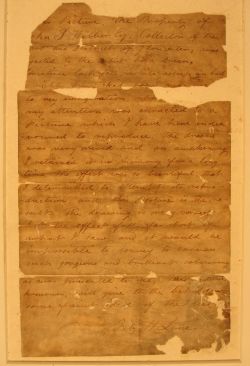

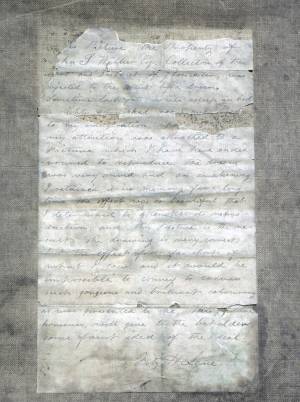
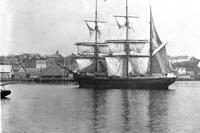

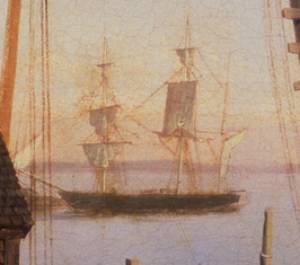


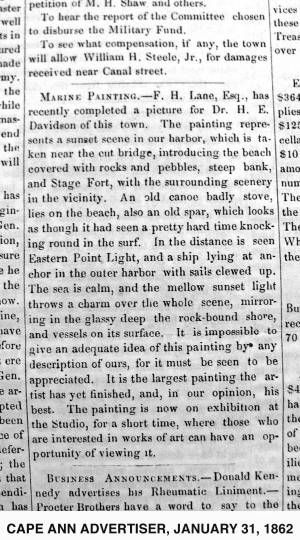


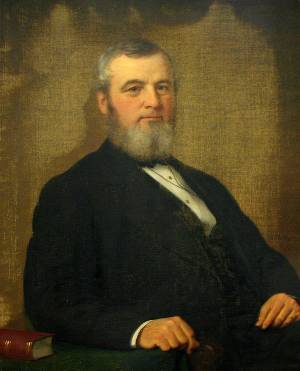
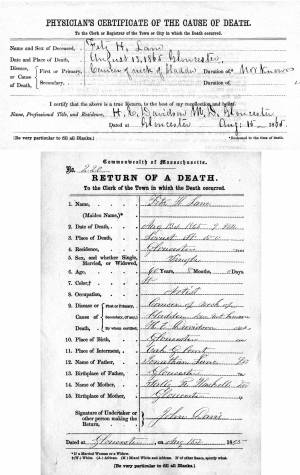

Commentary
In 1862, Lane moved out of his stone house on Duncan Point and stayed with his friends Dr. and Mrs. H. E. Davidson. During this visit, the idea for this painting came to him in a dream, as he recounted in a letter he wrote about its genesis. It is very unusual in Lane's oeuvre, and his only known painting of a purely imaginative subject. Lane writes:
[+] See More